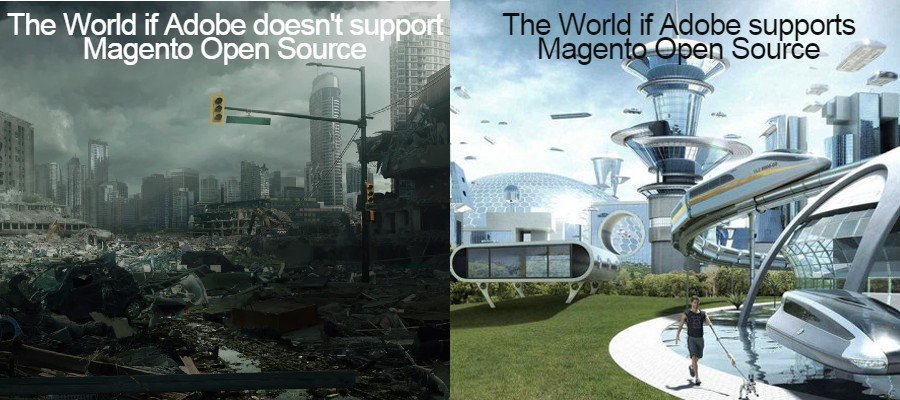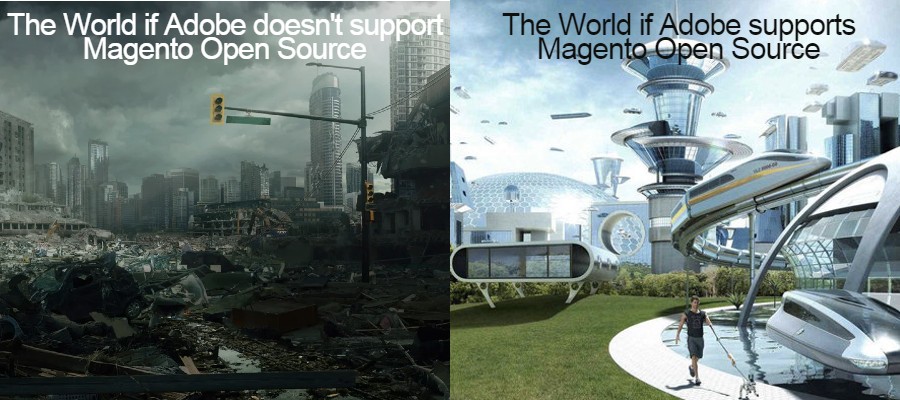
Your business’s breadth, goals, and resources determine your digital needs as a retailer. The smaller your company is, the more crucial the particular e-commerce platform’s capabilities are. Features are important for big market players too, but smaller entrepreneurs cannot afford to maintain way too complex systems. Having an ecommerce platform that perfectly fits your business demands and covers only the existing needs becomes more and more essential. For organizations at the lower end of the ecommerce spectrum, Magento Open Source has long been the go-to option inside the Adobe/Magento family. It even attracted numerous merchants from other platforms like Shopware or Shopify. However, there is a growing sense of unease over what is thought to be a lack of focus on Magento Open Source development: it seems that it will no longer be supported. Below, we explore the current situation. You will find out what’s going on with Magento Open Source and how Mage-OS is going to fix the current issues and provide other community initiatives with a particular plan on how to act in this situation.
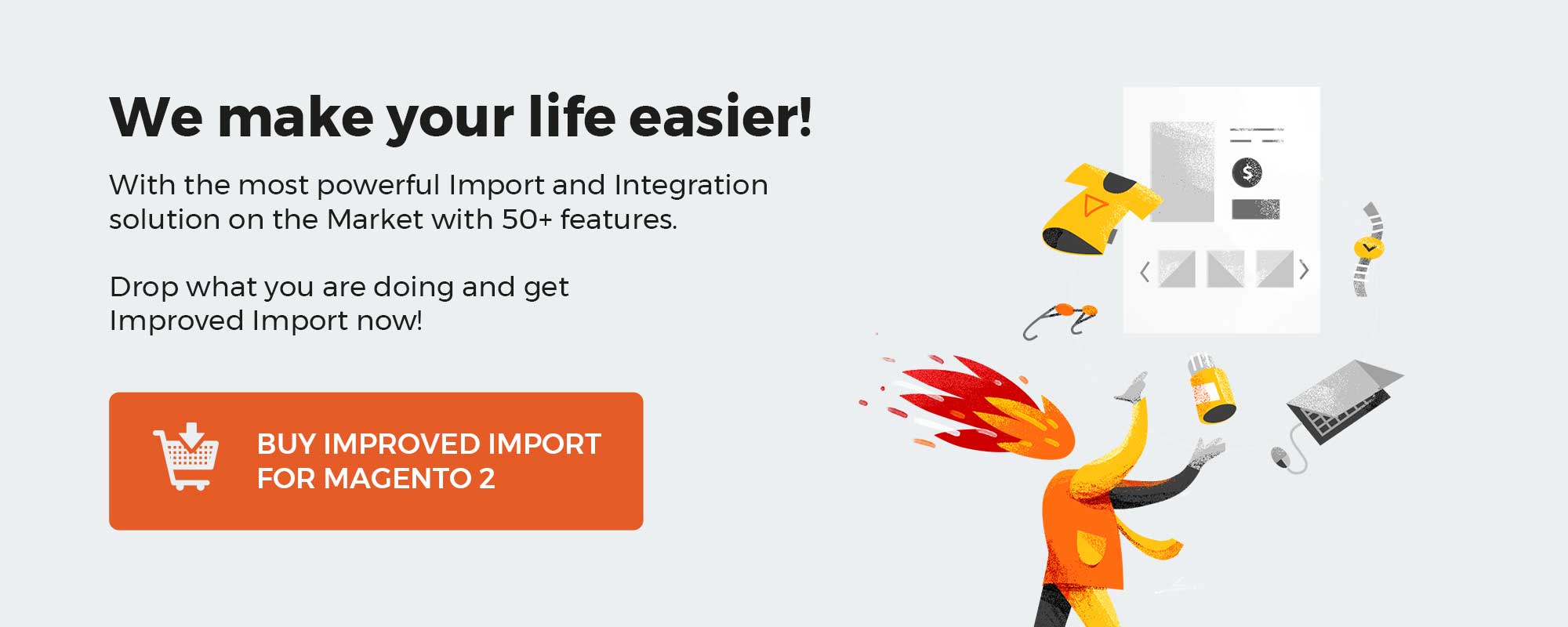
Table of contents
Introduction
Today, Magento is one of the most well-liked e-commerce platforms. Due to its reliability, potential, and huge customer base, Adobe announced the Magento acquisition in 2018. That’s when the first doubts regarding the platform’s future appeared. Both well-known Magento specialists and plain users were afraid that their favorite e-commerce system would gain completely new traits: its open source version would be abandoned, and the commerce iteration would become even more focussed on big market players. That’s what has happened.
Delivering the finest e-commerce technologies to its clients is something that Magento constantly aspires to do. It implements new features and refreshes the existing ones to keep up with the evolving market. However, people responsible for the platform tend to switch attention to more profitable business partners, leaving Open Source behind. Luckily, the Magento community reacts rapidly, delivering such projects as Mage-OS – an unrestricted effort to guarantee the availability, endurance, and success of the Magento platform and ecosystem.
Meet a lightweight, backward-compatible alternative to the Magento Open Source packages. Mage-OS Distribution covers modifications and additional features added by volunteers to the original Magento Open Source. As much as feasible, the project also strives to maintain compatibility with all current Magento 2 extensions and integrations. Before continuing with Mage-OS, let’s look at Magento’s impact on e-commerce and its story that led to the appearance of various community-driven projects.
Magento’s Impact on E-commerce
According to the BuiltWith website, 734,990 websites are now using Magento, including 162,787 currently live websites and an additional 387,267 domains that redirect to sites in this list. 572,203 sites used this technology previously. Thus, Magento is one of the fastest-growing eCommerce platforms, responsible for about 0.6% of the world’s websites. It is used by 0.9% of all the websites whose content management system we know.
Magento claims that its platform processes more than $155 billion worth of transactions annually. And it’s not surprising since the platform is used to create distinctive online storefronts by well-known retailers like Nike, Ford, and Nestle. However, trends change.
As you can see, the number of sites using Magento has reduced after a spike in 2019:
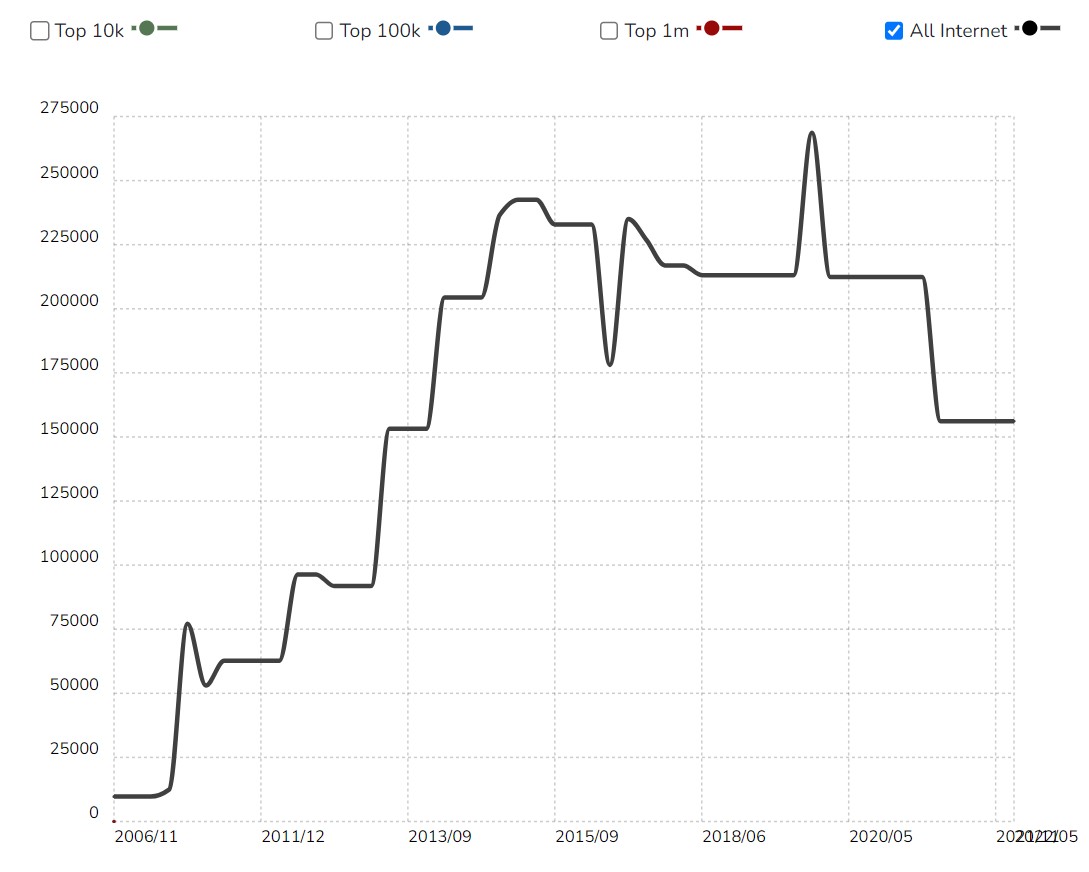
You can also see reductions in top 1m and 100k websites. The only segment where the popularity of Magento is growing is the top 10k websites. It means that the focus on huge market players works: bigger companies switch to Adobe Commerce, while smaller market players escape the ecosystem:
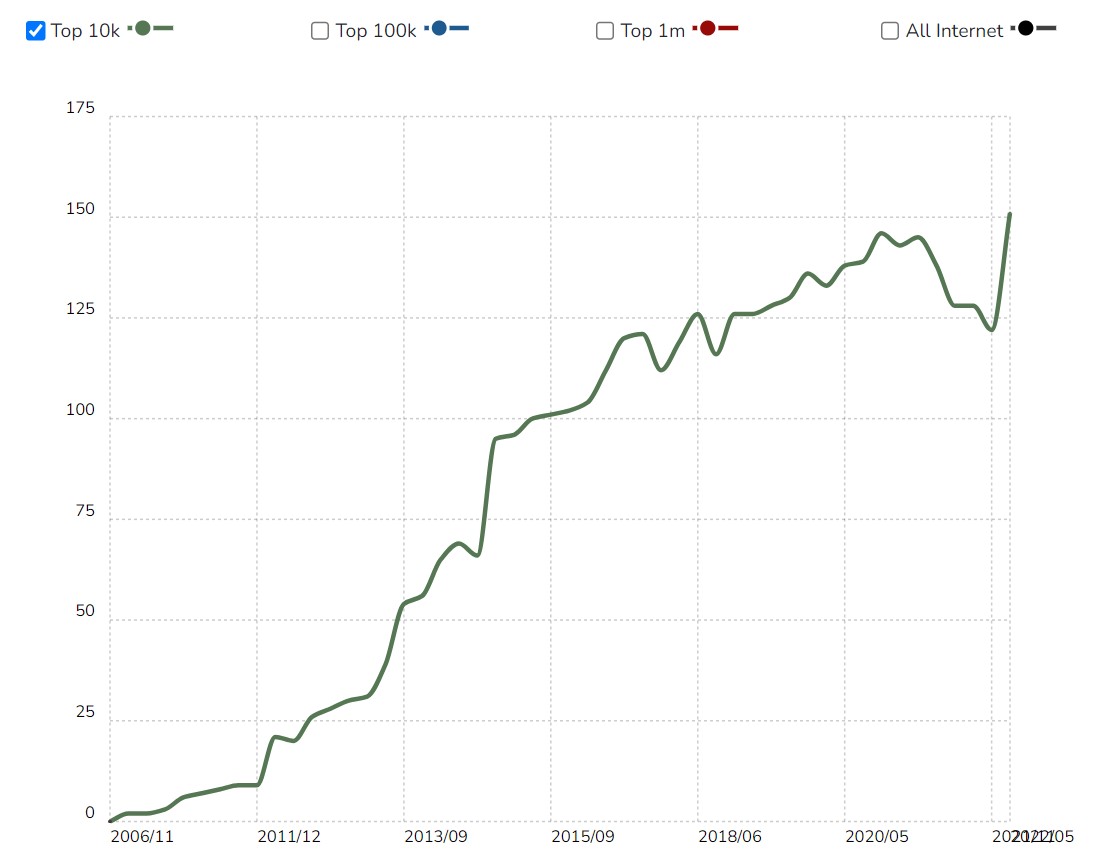
Let’s explore the Magento Open Source story to understand why everything happens like that.
Magento Open Source Story
An e-commerce platform called Magento Open Source was formerly known as Magento Community. Smaller online businesses usually utilize it for the scalability and flexibility it provides to rapidly expanding enterprises with annual revenue of under $3 million.
Another significant advantage of Magento Open Source is that it enables an international developer community to innovate and improve the platform, but it was not always like that.
Only 14 years have passed since Magento’s debut. Numerous smaller companies have benefited greatly from the Magento Community and Open Source since 2008 as they attempt to enter the e-commerce market and effectively grow their online clientele. This has been made possible in part by the scalability and adaptability Magento Open Source has offered.
A PHP framework of the “Monolith” type has historically been utilized by Magento Open Source. As a result, the frontend and backend remained integrated rather than separated. Smaller companies, who might lack the resources or experience to manage many systems, favor the homogeneity of the Monolith framework while operating their e-commerce site.
However, the broader e-commerce sector is increasing the focus on composable microservices hosted in the cloud. Despite being irrelevant to enterprises at the smaller end of the spectrum, additional solution types, including SaaS, PaaS, and off-premise, are becoming more and more valued.
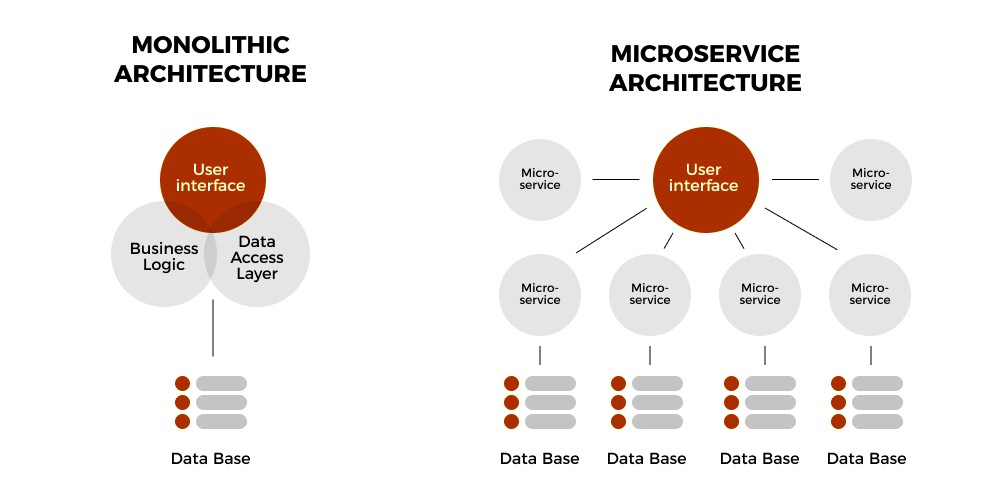
The PHP Monolith is reportedly being broken up by Adobe’s technical architects as a result of this change. If it does, Magento/Adobe’s DNA would be permanently altered.
The Magento Open Source community has grown frustrated at the idea of such a possibility. Some residents have made it their mission to steer the community in a more attractive direction. Along with them, we feel that the Monolith approach serves the SMB market the best, and, in many cases, this is true even for huge market players.
Apart from that, some community members adore the Magento Monolith and intend to continue using it for a long time. They truly believe that due to the lack of attention and innovation stall in recent years, it has not reached its full potential. Let’s analyze the Magento Open Source issue to get a better understanding of what’s going on and how the community is planning to prevent the catastrophe.
Analyzing Magento Open Source Issue with Mage-OS
So, what’s wrong with Adobe trying to avoid the Magento Monolith? Below, we explore the issue from the angle of Mage-OS.
Define the problem
The Monolith decision is only one thing that makes the Magento community feel abandoned and ignored by Adobe. People worry about the future of not only their favorite e-commerce platform but also a source of everyday routine. Thousands of merchants all over the globe sell their goods on Magento websites, while hundreds of developers in every country maintain these online storefronts. There are a few reasons why they feel upset.
Analyze the situation
As we’ve just mentioned, cloud-hosted microservices offered by Adobe Commerce are suited for the biggest retailers. You can read more about them here. In essence, this symbolizes the PHP Monolith breakdown. Consequently, community members that think the Monolithic strategy is a good one are concerned about Magento’s future.
The growing rift between Adobe and the community is another concern that grows from the discontent with the Open Source contribution model, lack of contact, and lack of a clear strategy for the Open Source product compared to the amount of communication and marketing around Adobe Commerce.
And, of course, Adobe’s key individuals with crucial roles left. These people could not be replaced, and at the same time, there was no compelling need to invest further money into open-source software.
That’s what’s happened recently and how the situation around the platform looks right now. It’s time to identify possible solutions to the Magento Open Source issue.
Identify possible resolutions
Our main goal is to explore both Mage-OS and the Magento Open Source future. In fact, when we talk about Mage-OS, we discuss the future of Magento. And when we explore how our favorite e-commerce platform may exist within the next few years, we cannot pass by Mage-OS because this project is virtually the Magento Open Source future. Let’s take a look at the two possible solutions Mage-OS proposes to address the current challenges the Magento community faces:
- To ensure the long-term health of all the businesses reliant on Magento Open Source, Mage-OS proposes to introduce a community-driven fork of Magento that is upstream compatible.
- By writing an open letter to the Magento community, the people behind the project propose to start a movement that will impact Adobe’s decision-makers.
So, we have two simple but effective solutions: a community-driven fork + better communication with people who maintain and use this fork. That’s it.
Find the middle ground
Mage-OS proposes to keep Magento alive and give it a bright future by putting the focus on merchants, both big and small. When the Monolith is ultimately deprecated, all companies will be able to continue using the benefits of the Monolith platform if they want.
The system should be at the same time compatible with all existing Magento 2 extensions and integrations as well as more accessible to developers. Another goal is to compose it off the default lightweight framework.
It’s going to be a collaborative effort, ideally together with the Magento Association (if you are not familiar with it, we describe this project below in a corresponding chapter).
Leverage benefits
Now, let’s talk about the benefits associated with Mage-OS. It seems that the project tends to deliver a win-win-win-win-win situation where all participants get advantages and face no drawbacks. Of course, it is only the representation of an ideal world. In fact, there should be issues that we will face but address – the Magento community did that multiple times before and will succeed in the future. So, what are the advantages Mage-OS has for merchants, agencies, technology partners, developers, and Adobe?
Merchants will be able to leverage the following benefits of the Mage-OS:
- Reduced development and maintenance costs. The new platform should be simpler and more accessible to a majority of developers than ever before. It’s one of the key goals behind Mage-OS;
- High scalability. Along with the new simplicity, Mage-OS should introduce advanced scalability that leads merchants from a tiny storefront up to Adobe Commerce and Experience Manager;
- Reduced hosting expenditures. Mage-OS is associated with simplified environmental requirements, thereby reducing hosting expenditures;
- The same ecosystem. Mage-OS should also be compatible with a broad variety of extensions and integrations that are already available for Magento and Adobe Commerce.
Looks like store owners will get a better, more flexible version of good old Magento Open Source with the existing ecosystem of tools, agencies, and developers but at the same time achieve higher scalability and reduce expenditures.
What about agencies? It seems that they should also benefit from the same advantages. From the agency perspective, Mage-OS looks as follows:
- Reliable employees. A more accessible codebase makes it simpler to onboard fresh talent and get reliable specialists on the team. Furthermore, already existing employees will also leverage the new simplicity;
- Favorable margins. The ability to target the smaller SMB market with favorable margins is made possible by shorter build times and less complexity. Thus, agencies can get more clients since better conditions will definitely attract more merchants;
- Efficient workflow. Less development frustration and more efficient workflow will not only inspire your teams but also increase talent retention, reducing development and maintenance costs.
The enhanced version of Magento Open Source will give lots of opportunities to agencies too: from new reliable employees to additional clients.
Technology partners, in their turn, can gain better business results and growth as the Magento market share increases:
- New merchants and agencies. Mage-OS will open access to the lower-end SMB market, targeting new merchants and agencies;
- Bigger ROI. It will also result in better ROI for existing products caused by a longer Magento lifespan.
Technology partners will benefit from the advantages merchants and agencies get. Also, Magento will become more profitable for them due to its continued lifespan.
As we’ve already mentioned, developers will also get a bunch of enhancements associated with Mage-OS. For instance:
- Increased sense of ownership. A slightly altered nature and laws of Mage-OS will help developers not only get this sense but also benefit from more essential ownership.
- Faster distribution. More rapid distribution is another strong advantage associated with improved technologies hidden behind Mage-OS.
- Simplified participation. Mage-OS promises that it would be much easier to take part in the project, leaving traces within the system.
- Better development environment. Developers will find it easier to create a working space.
- Rapid start. Due to enhanced technologies and simplified conditions, Mage-OS introduces an excellent starting point for a career as a developer in the Magento/Adobe Commerce ecosystem;
- Longer lifespan. A Longer Magento lifespan with a higher return on investment for learned Magento development skills is another important thing developers should think about.
It seems that Mage-OS delivers better working conditions for developers. They will face fewer headaches and easier routine processes.
Even Adobe can benefit from the use of Mage-OS. The company will get the following perks:
- Reduced pressure on the GitHub PR/Issue list. First of all, it will benefit from lowered stress on the GitHub PR/Issue list for the Magento Open Source project.
- More stable products. The company will maintain stability, providing a barrier between community contributions and Adobe Commerce. Community contributions can work in production environments without endangering the stability of Adobe Commerce or Magento Open Source.
- Additional clients. And don’t forget about retailers who may move from Mage-OS into Adobe Commerce and Adobe Experience Manager as their business grows.
- Return of SMBs. There is also a possibility to protect and increase the market share of the lower-end Magento SMB market associated with the popularity of Mage-OS.
- Vivid community. Last but not least, the platform’s active community introduces a competitive advantage over other platforms.
All these thoughts saw the light of the day in September 2021. As you can see, the giant corporation should be motivated enough to let Mage-OS appear and drive the future of Magento. Is there anything Adobe should be afraid of? It doesn’t seem so. What about other categories described above? We also don’t know how Mage-OS may hurt them. The project gradually moves towards its legitimate place in the market. As of February 2022, its efforts were not in vain. They resulted in the following implementation.
Mage-OS – The Future of Magento Open Source
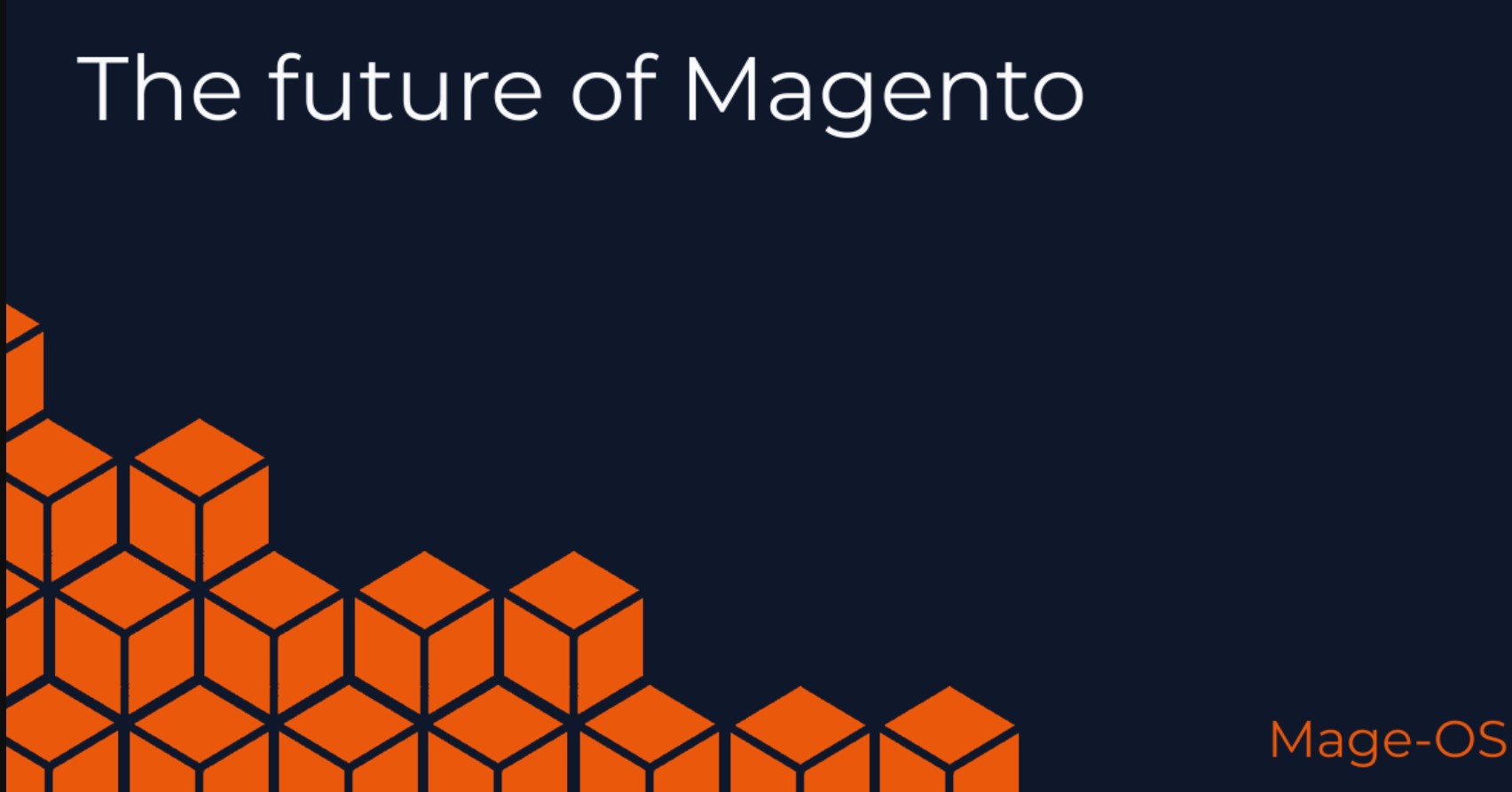
Due to the Mage-OS efforts, Adobe noticed the community. It still cares about the Open Source version and promises to pay more attention to it. There is a demand for an open strategy that is partly satisfied by a commitment to the long-term support of Magento Open Source, which, in turn, results in the Open Source Task Force by the Magento Association.
Furthermore, the community and Adobe get together to discuss all the concerns, negotiate on the platform’s future, and find common ground on essential aspects. It seems that Adobe wants to fix the relationship between the platform and its community, isn’t it?
According to Peter Rusin, Mage-OS has meetings once in two weeks. However, results vary a lot. Within the first eight calls, about 10 people joined the discussion. Almost half of them were Adobe employees. The rest of the participants were community members, including people behind Mage-OS. Not so much, but always better than nothing. And don’t forget that the results of these negotiations are more valuable than the number of their participants. Even if two people negotiate, resulting in positive changes, it is better than 1000 people discussing the future of Magento with zero impact on it.
At that point, Mage-OS got an alignment on what the community requires from Adobe and what Adobe can provide. That’s a good start. And what’s even more important, Adobe has made two commitments. Firstly, it is going to keep investing in Magento Open Source. That sounds great since there is no plan to abandon the platform. However, the amount of investments is unclear. So there is uncertainty on how long the company will keep the project running and what money it is going to spend on Magento Open source.
Secondly, despite the previously published opinion, Adobe is not going to deprecate the Monolith. That sounds even better because there is no uncertainty anymore. SMBs won’t lose the ability to leverage the benefits associated with the Magento Monolith. And Mage-OS should make the use of this technology even more advantageous.
Other important takeaways include:
- New release strategy. There will be a new release strategy for Adobe Commerce and Magento Open Source: LTS and STS. LTS – Long Term Support – will be maintained by Adobe, primarily providing compatibility, stability, and security updates along with bug fixes. It seems that each released version would be supported for about five years.
As for STS, it is a short-term support version that will be maintained by the Magento community. Developers all over the globe will be able to advance the product via pull requests.
Since the two versions won’t be independent, the STS one will receive the updates from the LTS branch. At the same time, selected STS contributions will be merged into LTS. Thus, knowledge of the Community and the value of Magento Open Source is expanding within Adobe.
For the next few years, Adobe will take care of the fundamental requirements so that Magento Open Source can continue to be used. 100% vendor support for security updates, stability fixes, and critical problems should be provided. - Luma deprecation. Although not immediately, Luma will be deprecated. The requirements of today are rising dramatically, and the conventional frontend theme “Luma” doesn’t keep up with them. By default, Luma will be removed from the core in the fork in order to provide new features and repackage Luma as an LTS version.
A lot of people choose Hyvä (we will describe it in a few words below since it is also a huge part of the Magento future), while some utilize PWA Studio or other PWA frameworks. This is just one instance of how various solutions from the community, Adobe, or SaaS suppliers appear on top of the reliable Magento basis. - Compact core. Mage-OS introduces the future potential for the Magento Framework’s core to be reduced in size to support more distributions. The community is going to get rid of all the unnecessary things, optimizing everything that’s left. However, functionalities in the core that are optional, like the option to choose between Elasticsearch or MySQL search, or to remove MSI (Multi Stock Inventory), will by default be in the fork.
- Performance. The speed of bug fixes will increase. Along with that, Mage-OS will bring speedier implementation of performance upgrades.
- Marketing. Adobe won’t do any marketing efforts towards Magento Open Source aimed at retailers on either the magento.com or the adobe.com websites. At the same time, the magento.com domain now points to an adobe.com landing page with Magento-related resources.
- Evergrowing ecosystem. The Magento ecosystem will continue to evolve due to the strength of the community and the support of major companies. It already includes hundreds of extension vendors who are not going to leave the market. Furthermore, they continue updating their products as well as providing new modules from time to time.
- Microservice integration. Instead of creating new functionality with Magento (PHP) extensions, Adobe intends to create integrations for microservices and other Adobe applications.
- Fork tracking. When a new fork is made, the official Magento repositories track it in a new way. The fork, in its turn, automatically updates and tracks changes made to the official Magento repositories. It then produces meta-packages from the repository and adds them to the distributed repository that Composer uses. The fork serves as a backup plan in case the official Magento repository experiences significant deprecations or is completely removed. By creating a fork of the product, Mage-OS hopes to have full control over the copy and the related know-how.
- Transparency. Mage-OS seeks complete transparency. Discussions about processes will be held on Discord. Using it as a primary communication platform, Mage-OS will be made available to the general public. Setting up the system and infrastructure needed to make Mage-OS a long-lasting project is among key priorities.
- Events. Magento events must return to inform and welcome newcomers and assist one another by offering answers to common challenges.
Although it is evident that Adobe won’t invest heavily in any innovation or feature for Magento Open Source, Mage-OS ignites a movement that will probably pave the way for Magento’s evolution for the next couple of years.
Get Involved
Since Mage-OS is a community initiative, you can get involved with it easily. The project intends to foster an open, positive, and inclusive community. Read the Code of Conduct for further information. If you want to join the corresponding discussion, pick one of the following sources:
Becoming a member of Mage-OS is associated with several nuances. Firstly, you need to become a card-carrying participant. However, there is no particular explanation of what it is. It seems that fees enter the game at this point. After that, you get the ability to support the ongoing development of the Mage-OS platform directly. It means that you can vote in Mage-OS elections, resolutions, and directions.
Along with that, it is possible to support Mage-OS as a company. This opportunity is associated with higher fees that are not announced yet.
Please, join the email list or Discord to be among the first community members who will learn about the new features.
In addition to that, you can become a contributor to Mage-OS. Simply contact the project by reaching out to Mage-OS on Discord in #tech, clone the repository, and start submitting your pull requests. However, you must keep in mind that all contributions should follow the Code of Conduct and the corresponding code standards. Mage-OS keeps the right to decline contributions if they are not in line with the project’s vision and direction.
About the Mage-OS Association
The Mage-OS Association was founded by members of the Magento community as a non-profit organization to represent and advance the interests of the community as a whole, including those of merchants, developers, agencies, and all the numerous individuals who support and are supported by this ecosystem.
An open letter concerning the future of Magento first presented the concepts behind Mage-OS. The message sparked debate and movement throughout the neighborhood. 1,641 individuals who use, create, or in some other way rely on Magento for a living have signed the letter. The concepts of that letter come to life in Mage-OS.
The mission behind Mage-OS is to see Magento prosper. It aims to expand the community, grow the ecosystem market share, and sustain Magento as a number one platform for custom e-commerce development.
The project intends to accomplish those goals by directing and sponsoring Mage-OS’s long-term development and maintenance through top-notch content that ensures the platform’s long-term survival and funding activities that fit the association’s objectives. Providing evidence and routes for education and certification is another mission of Mage-OS on the way to assist businesses in empowering the Magento Open Source community.
Other Terraformers
Let’s briefly describe two other projects that definitely form the Magento future: Magento Association and Hyvä. Their impact on the entire ecosystem is evident.
Magento Association
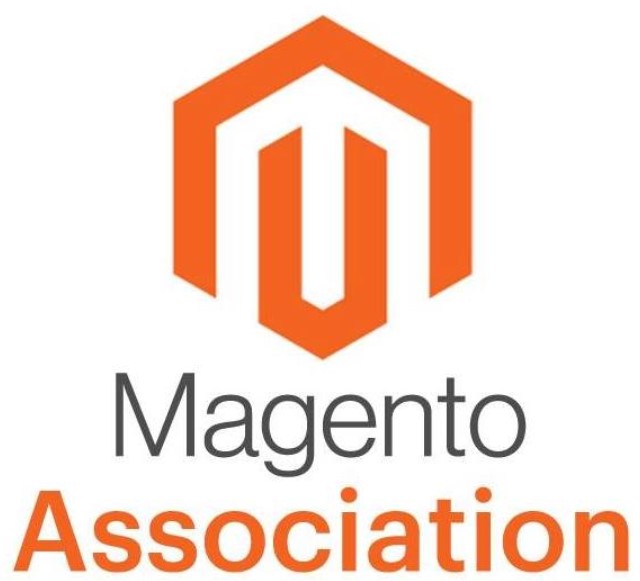
Back in 2018, Adobe announced an important step toward the Magento community. The corporation promised to create a brand new organization with the aim of building a bridge between its products and the community existing around them. The new organization was called the Magento Association. Today, it is available to community members all over the globe, empowering every single participant.
The Magento Association is committed to encouraging and supporting technological endeavors, community gatherings, instruction and training, and online communication. The Magento community has a long history of creating successful events and cooperative projects across borders. The Magento Association is expanding on this to realize the vision of a powerful, open, and healthy Magento ecosystem right now and in the future.
There is a lengthy antecedent to the Magento Association’s emergence. The initiative’s history began long before 2018. From the beginning, the platform began to draw users who were curious about the newest technology. The 14-year journey since its initial release on March 31, 2008, has dramatically altered the way it appears, feels, and functions. As one of the most widely used e-commerce platforms on the Internet, Magento today provides a rich feature set in addition to exceptional flexibility and scalability. And the role of the Magento Association in this journey is hard to overestimate.
The Magento Association became an instrument to formalize and recognize the platform’s open-source community with the help of initiatives, events, education, and online engagement within the ecosystem.
Today, the Magento Association intends to address a variety of problems and enhance communication inside the network. It takes advantage of the Magento community’s long history of creating collaborative programs and successful events, adding a new degree of organization and effectiveness.
Since an open and thriving ecosystem is the organization’s ultimate goal, the Magento Association regularly deals with the following issues:
- Lack of communication between community events;
- Event localization;
- Merchants’ lack of influence in the community;
- Popularization of Magento events among merchants.
So, it seems like Magento Association may play a pivotal role in the future of Magento Open Source. The community requires it and interacts with Adobe through the Magento Association. Does it work like that? Time will show.
Hyvä

Hyvä themes represent a brand-new frontend for Magento 2 with the best developer experience, performance, and TTM. Due to this project, many people restored their faith in Magento. It introduced the ability to create Magento 2 shops quicker and with a lower budget, getting a modern and ultra-fast browser experience for visitors.
Hyvä Themes, by default, include only 2 dependencies: TailwindCSS and AlpineJS. The purpose is to lower dependencies to 3rd party libraries and keep the technology stack limited to as few as possible. Looks like we can experience the Magento future right now, especially considering the following core principles of Hyvä:
- Reduced complexity and dependencies;
- Better performance;
- Developer-friendly experience;
- Enhanced development velocity;
- Much smaller learning curve.
Hyvä offers a reliable alternative for individuals who are not particularly enthusiastic about PWAs, which are quite popular nowadays. PWAs require lots of resources to create a truly fantastic online store; therefore, they are less appropriate for the kind of merchants that a typical agency works for.
Hyvä themes, on the contrary, reduce that gap so that Magento continues to be the best option for retailers of all sizes and that agencies can stick with the platform and capitalize on their experience by employing both Hyvä and PWA solutions where it best suits their customers’ needs.
Conclusion
In our opinion, it’s crucial to keep Magento Open Source rolling. It is also vital to make Magento platform contributions and innovation simpler. And Mage-OS does a lot to do that by requiring a community fork of the Magento core. It aims to keep that branch in sync with the legitimate Magento repositories. To achieve this goal, the project will develop an innovative, upstream-compatible fork of the Magento Open Source project.
Also, a body that can provide the resources necessary to support and preserve this fork, creating a bridge between its community and Adobe, is required. If the Magento Association could win the support of the community, it might be able to carry out this function. It should, therefore, only serve the interests of the community. People behind Mage-OS are actively in contact with the Magento Association to investigate the possibility of harmonizing the future visions of Magento.
They believe, and we totally agree with them, that it is critical to be able to plan the future and openly address the potential repercussions of Adobe deprecating the Magento Monolith at some point in the future, which is why a number of businesses and individuals from the Magento community will always be interested in finding possible resolutions.
While everyone, including the Firebear team, waits for Adobe to make a decision about their public roadmap, Mage-OS already helps to prepare for a variety of scenarios. The success of Magento has always been fueled by the community, and, if necessary, together, we will step up and offer the tools to keep Magento Open Source going.
[embedded content]

